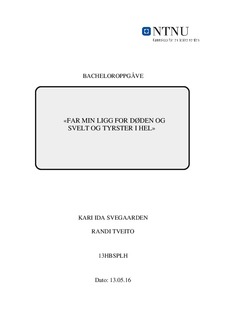| dc.contributor.advisor | Simonsen, Siri G. | |
| dc.contributor.author | Tveito, Randi | |
| dc.contributor.author | Svegaarden, Kari Ida | |
| dc.date.accessioned | 2016-09-08T06:35:48Z | |
| dc.date.available | 2016-09-08T06:35:48Z | |
| dc.date.issued | 2016-09-08 | |
| dc.identifier.uri | http://hdl.handle.net/11250/2405212 | |
| dc.description.abstract | Introduksjon: Pasientar ved livets slutt har redusert behov for væske og ernæring. Det kan vere vanskeleg for dei næraste å sjå sin pårørande ikkje klare å ete og drikke meir, og derfor ynskje å sette i gang av væske- og ernæringsbehandling. Hensikt: Klargjere ulike faktorar som kan skapa splid i spørsmålet rundt væske og ernæring blant pasient, pårørande og helsepersonell. Metode: Oppgåva er basert på litteraturstudie som metode. Det er utført systematisk søk i databasene Ovid nursing og CINHAL Complete. Hovudresultat: Manglande informasjon, kunnskap, religiøse og kulturelle forskjellar kan vere årsakar til at splid oppstår rund besluttningsprosessen om væske- og ernæringsbehandling ved livets slutt. Det vert avdekka at helsepersonellet ikkje har klare nok rutinar rundt informasjonsgiving til dei pårørande og når den palliative fasen skal starte. Funn viser at pårørande har eit behov for å få betre kunnskap og informasjon om fysiologiske endringar hos pasienten ved livets slutt. I tillegg treng både pasienten og deira pårørande informasjon rundt verknad og biverknad ved væske- og ernæringsbehandling. Konklusjon: Helsepersonell har ei viktig oppgåve i å sørge for at pasient og deira pårørande er innforstått med verknad og biverknad av væskebehandling. Utan denne forståinga klarer ikkje pasienten å ta ei beslutning på riktig grunnlag. Tydelig og relevant informasjon er derfor heilt sentralt for å førebyggje ueinegheitar i væske og ernæringsspørsmålet ved livets slutt. | nb_NO |
| dc.description.abstract | Introduction: Patients at the end of life have a reduced need for fluids and nutrition. It may be hard for the closest family to see their loved ones not being able to eat or drink anymore. They may therefore wish for their loved ones to get fluid and nutrition therapy. Purpose: Specify various factors, which could create conflict in question around fluid and nutrition therapy among patients, families and health care professionals. Methods: The thesis is based on a literature study. Structured searches are made in the databases Ovid Nursing Database and Cinahl Complete. Main results: Some of the key causes of disagreement around the decision making process is lack of information and knowledge, and religious and cultural differences. The results show that health care professionals lack good procedures when it comes to giving information to near family. They also should be more clear when it comes to starting the palliative phase. The results show that the family have a need for more knowledge when it comes to fluid and nutritional therapy, and the changes in a dying body. Furthermore, both patients and their family need more information about the cost and benefit of fluid and nutritional therapy. Conclusion: Health care professionals have an important job in ensuring that patients and their family are aware of the benefits and burden hydration therapy can give. Without this understanding, patients cannot take a well-qualified decision. It is important that patients and their families get relevant information on the issue from health care professionals, to prevent disagreement when the patient is approaching death. | nb_NO |
| dc.language.iso | nno | nb_NO |
| dc.subject | Informasjon | nb_NO |
| dc.subject | ernæring | nb_NO |
| dc.subject | hydrering | nb_NO |
| dc.subject | livets slutt | nb_NO |
| dc.subject | beslutning | nb_NO |
| dc.subject | Information | nb_NO |
| dc.subject | nutrition | nb_NO |
| dc.subject | hydration | nb_NO |
| dc.subject | end of life | nb_NO |
| dc.subject | decision | nb_NO |
| dc.title | Far min ligg for døden, og svelt og tyrster i hel | nb_NO |
| dc.title.alternative | My father is dying, and he's starving and thirsting to death | nb_NO |
| dc.type | Bachelor thesis | nb_NO |
| dc.subject.nsi | VDP::Medical disciplines: 700::Health sciences: 800::Nursing science: 808 | nb_NO |
| dc.source.pagenumber | 47 | nb_NO |
